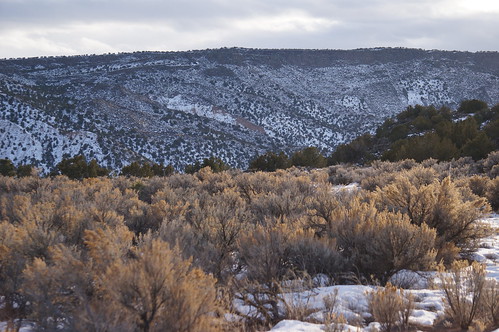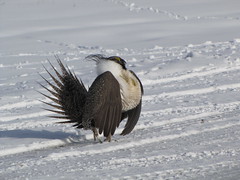美國內政部長Sally Jewell 14日和土地管理局副局長Steve Ellis、參議員Mike Crapo和James Risch、地方利益關係人以及牧場業主,一同檢討山艾樹生態的保育成果。山艾樹林是美西重要的野生動物棲地,也是民眾戶外休閒和從事其他經濟活動的去處。
美國魚類及野生動物管理局正在考慮是否於2015年將大艾草松雞納入瀕危物種保育法保護對象。在此之前,欲發展和執行大艾草松雞保育計畫,除了美國政府和西部各州的努力外,地主的支持也是不可或缺的一環。
大艾草松雞因求偶儀式花俏而聞名,與超過350種野生動物共享山艾樹棲地,包括麋鹿、長耳鹿、叉角羚和金鵰。此外,牠也是所謂的「保護傘物種」──若保護傘物種獲得完善保育,也能連帶保護到其他生物。
雖然艾草松雞1億6千5百萬公畝的棲地有約64%位於聯邦管理土地上,但因為私有土地內有重要的河岸和沼澤草地棲息地,也攸關著艾草松雞的存續。
大艾草松雞棲息範圍曾遍佈西部2億9千萬英畝的山艾樹林,但現在卻失去近半數的棲地。早期屯墾者曾目睹天空佈滿樹百萬隻松雞;現在只剩200,000到500,000隻還生活在11個州和兩個加拿大省份。
南愛達荷州Browns Bench/China山區曾被2007年的大火破壞,超過600,000英畝面積被燒毀,包括大部分的山艾樹林,是1910年以來最大的草原火災。
聯邦、州政府和地方合作夥伴正透過空中和地面播種方式重建山艾樹族群,對抗雀麥草和外來種,改善消防制度,並規劃隔火設施以限制未來火勢惡化程度。
「大火燃燒時間變長、溫度變高,速度也變快,是山艾樹棲地減少超過一半的原因之一。」Jewell說,「愛達荷州的各界合作關係將恢復美國重要自然景觀、重建對西部野生動物和經濟活動至關重要的山艾樹生態,並樹立保育典範。」
Secretary of the Interior Sally Jewell today joined Bureau of Land Management Deputy Director Steve Ellis, U.S. Senators Mike Crapo and James Risch, local stakeholders and ranchers to view efforts to conserve the sagebrush habitat that supports wildlife, outdoor recreation and other economic activity throughout the West.
The support of landowners is key to a joint effort by the U.S. government and Western states to develop and implement a broad conservation plan for the Greater Sage-grouse before the U.S. Fish and Wildlife Service has to decide whether or not to propose the bird for Endangered Species Act protection in 2015.
Known for its flamboyant mating ritual, the Greater Sage-grouse is an umbrella species, sharing the sagebrush with more than 350 other kinds of wildlife, including elk, mule deer, pronghorn antelope and golden eagles.
While roughly 64 percent of the Sage-grouse’s 165 million acres of occupied range is on federally managed lands, private lands are critical for the species, often including limited and vitally important riparian and wet-meadow habitat.
Jewell, Ellis and Crapo toured the Browns Bench/China Mountain region of southern Idaho and some areas that were devastated by the 2007 Murphy Complex Fire. Burning more than 600,000 acres, much of it sagebrush habitat, the fire was the largest rangeland fire since 1910.
Federal, state and local partners are restoring the area by reseeding sagebrush from the air and with machines on the ground, combatting cheatgrass and other invasive species, altering fire regimes and creating fire breaks to limit the damage from future fires.
“Fires are burning longer, hotter and faster, and it’s one of the reasons that we’ve seen the range of sagebrush habitat cut by more than half,” said Jewell. “The partnerships in Idaho to bring this key American landscape back are models of what we need to conserve and restore sagebrush habitat that is so important to wildlife and the Western economy.”
Greater sage-grouse once occupied more than 290 million acres of sagebrush in the West, but the bird has lost more than half of its habitat. Settlers reported that millions of birds filled the skies; now between 200,000 and 500,000 birds live in 11 states and two Canadian provinces.
※ 全文及圖片詳見:ENS







